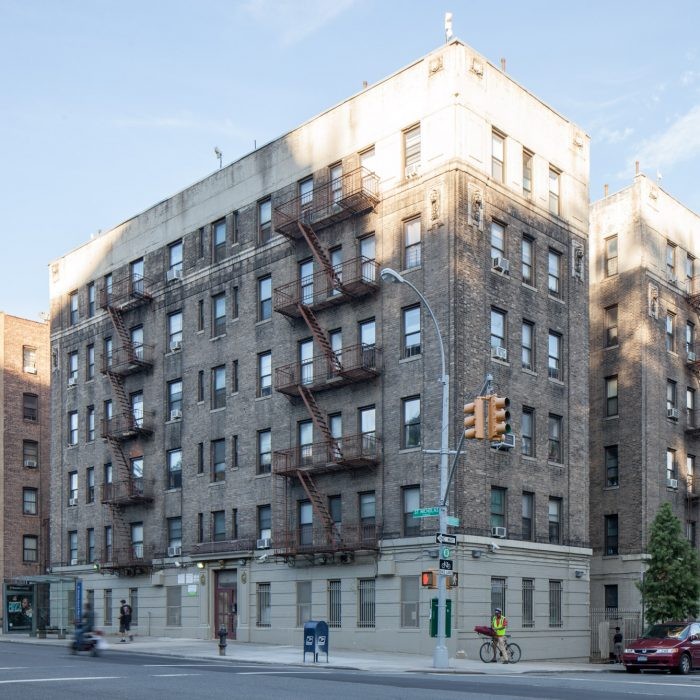580 Saint Nicholas Avenue (Regina Anderson Andrews' Apartment)
Introduction
Text-to-speech Audio
Images
580 Saint Nicholas Avenue, New York, taken by Christopher D. Brazee for the NYC LGBT Historic Sites Project, 2016.

Backstory and Context
Text-to-speech Audio
Regina Anderson Andrews was born in Chicago, Illinois in 1901 to William Grant Anderson and Margaret Simmons. Though the family was seen as Black, in reality, race was a very complicated concept for everyone in the family. When asked her race in a job interview, Anderson wrote American, and the interviewer replied, "To us you're not an American. You're not white" (Whitmire, 2007). After her parents' divorce, Andrews was sent to Normal, Illinois to live with her grandfather in 1911.
In 1923, after her sister's death, Regina moved to New York. Regina lived at 580 Saint Nicholas Avenue with roommates Ethel Ray Nance and Louella Tucker. This move to Harlem put her in the perfect position to get to know and befriend numerous famous artists involved in the Harlem Renaissance. The apartment on Saint Nicholas Avenue functioned as a meeting space for the women and their friends – it was even the space where Langston Hughes met his lifelong friend, Carl Van Vechten (Whitemire, 2014). In an interview with David Taylor, Ethel Ray Nance said, "And as I said, with Regina in the library, it gave us access to a lot of people...they really used our home if there was some people in town because we could get a group together very quickly" (Taylor, 1974).
Renowned actress Ethel Waters lived just across the hall. Regina formed friendships with W. E. B. Du Bois, Charles S. Johnson, Zora Neale Hurston, and James Weldon Johnson, among other well-known people involved in the Harlem Renaissance. Through these new friendships, Anderson was given the chance to develop her playwriting skills. She served on the executive board of the Harlem Experimental Theatre, which, "offers opportunities for young Negro Playwrights and Actors who wish to aid in the Negro's Contribution to Art in America" (Whitmire, 2007). Two of Regina's own plays were produced by the Harlem Experimental Theatre. The Harlem Experimental Theatre was even housed in the 135th Street Branch where Regina worked before transferring to St. Philip's Church Parish House (Whitemire, 2007).
Though many married women stopped working at libraries, Regina began working at the New York Public Library after marrying William Andrews in 1926. She "believed she was neither being paid a wage that recognized her contributions nor being afforded the opportunities for promotion she deserved" (Whitmire, 2007). W. E. B. Du Bois often stepped in to support her, requesting more diversity within the staff at certain branches of NYPL. Du Bois wrote in a letter, "[W]hile apparently there are forty-two branches where white assistants may get their experience and promotion, there are only two or three where colored girls will be tolerated" (Whitmire, 2007). Du Bois and many of his colleagues boycotted the library in support of Regina, saying that she, "had been denied, on account of color prejudice," and that, "I do not care to speak at the library until... barriers based on color prejudice are removed from the path of any colored person in the New York Public Library system" (Whitmire, 2007). In June 1930, Andrews was hired as an assistant branch librarian.
In December 1936, Andrews transferred to the 115th branch. The patrons of this branch (as many of the others at which Andrews worked) were mostly people of color. Beyond her librarianship, Regina did all sorts of work to discuss racial politics with the rest of the world (Whitmire, 2009). She even worked as a UN observer and hosted events that guests like Eleanor Roosevelt attended (Whitmire, 2009). This work gave her the opportunity to travel around the world to share her knowledge and advocate for African-Americans.
"Through the force of her...activism in the Black community of Harlem, Regina Anderson would rise to become the first African American to head a branch of America's largest public library system" (Whitmire, 2007). She refused to let anyone define her by her race or their opinions of her. She worked hard to open the door not only for herself, but for Black librarians who came after her. Whitmire wrote, "In a 1938 speech... Andrews said, 'We must be more than librarians'" (2007). She set a standard for librarians to think beyond what they do inside their brick and mortar walls, suggesting that library work must also be done in the community.
Sources
Whitmire, Ethelene. 2007. “Breaking the Color Barrier: Regina Andrews the New York Public Library.” Libraries & the Cultural Record 42 (4): 409–21. doi:10.1353/lac.2007.0068.
Whitmire, Ethelene. 2009. “‘The Evening Under the Stars:’ The Cold War Adventures of a Negro Librarian.” Conference Papers -- Association for the Study of African American Life & History, 146.
Whitmire, Ethelene. "Andrews, Regina (1901-1993), librarian and dramatist." American National Biography. 1 Oct. 2014; Accessed 6 Dec. 2019.
http://www.nyclgbtsites.org/site/ethel-waters-residence/
